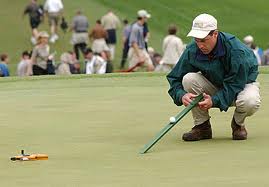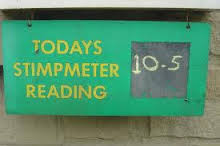Stuck on the Stimp
Ah, yes…. the stimpmeter. A simple tool used to determine consistency on putting green surfaces…. and, obviously, speed. Superintendents check the speed of the greens from time to time in relation to surface contour and slopes, to help in identifying proper cupping areas. And when readings meet the acceptable range, then the green speeds are on target for health of the turf and for meeting playability standards.
While the stimpmeter has been around since 1977, the years to follow now have American golf heading toward the dark side, being completely obsessed with green speed. Now with our issues with slow play and the climate concerns for maintaining greens, I might like to see the stimpmeter go on sabbatical.
Many private clubs seem to be in some sort of a competition to see who has the fastest greens. Their superintendents are pressured regularly by appointed club leaders to constantly lower height of cut and establish borderline green speed standards… and their job performance is then judged by their ability to deliver said green speed conditions. Seriously. Talk about a job from hell!
 Some courses go as far as posting their daily stimpmeter readings at the first tee – just to make sure the players have this valuable data to consider. Really? Have these players not already got enough to think about?
Some courses go as far as posting their daily stimpmeter readings at the first tee – just to make sure the players have this valuable data to consider. Really? Have these players not already got enough to think about?
As a consultant, I get pushed once in a while to make a statement about green speeds, with questions like, “What should our average green speed be? Or, “What should be our standard?” As I have become wiser, I resist even discussing a number or even a range. I simply say that the green speed should first be a product of healthy turf and second, be a height of cut that is appropriate for the slope and contouring of the green. Furthermore, I promote that the most important considerations of a green surface are basic - simply be healthy and true.
A stimpmeter reading is really irrelevant if the grass is suffering or if there is limited cupping due to slope and speed. So why be so fixated on the numbers?
I recall earlier this year, prior to the first round of the PGA Championship at Oak Hill, a press conference was held with Kerry Haigh (Chief Championships Officer for PGA). The media pressed Kerry to make a statement about the expected green speeds during the week of the tournament…stimpmeter numbers. Kerry provided a simple answer, with a smile…”Championship speed”. When pressed again, Haigh replied with the following, which every facility in the US should adopt:
“It’s a speed that’s appropriate to the greens that we feel is right. We don’t give out a number. To be honest we don’t think that’s necessarily good for the overall country clubs out there; I don’t. I think everyone hears a number and then everyone starts saying, well, we need it at this number. I think all clubs should set at a green speed that is appropriate for their play and the quality of their members and the slope of those greens. Throwing out numbers, I’m just not comfortable; so it’s a green speed that is appropriate for a championship and the best players in the world”.
 About a year ago, I polled the many superintendents that I have had the pleasure of working with through the years. The first thing I asked them all was whether they used a stimpmeter. Most of them said they still owned one, but that they no longer took regular measurements. Then I asked whether their club had established any standard speeds. Only a few responded positively on that – most said that they had done away with it, or in some cases had established a general range of acceptability. My final question was whether they posted their measurements or made the information available to members/golfers. I was pleased to hear that only one superintendent still published/posted this information – but it was because he was required to do so. Several of the guys said they didn’t even know where their stimpmeter was anymore – and it didn’t matter anyway. I was obviously pleased that the majority of my clients have already been downplaying the stimp and speed to a certain extent, but I hear new horror stories often.
About a year ago, I polled the many superintendents that I have had the pleasure of working with through the years. The first thing I asked them all was whether they used a stimpmeter. Most of them said they still owned one, but that they no longer took regular measurements. Then I asked whether their club had established any standard speeds. Only a few responded positively on that – most said that they had done away with it, or in some cases had established a general range of acceptability. My final question was whether they posted their measurements or made the information available to members/golfers. I was pleased to hear that only one superintendent still published/posted this information – but it was because he was required to do so. Several of the guys said they didn’t even know where their stimpmeter was anymore – and it didn’t matter anyway. I was obviously pleased that the majority of my clients have already been downplaying the stimp and speed to a certain extent, but I hear new horror stories often.
I suppose my wish would be for golfers to place more trust and confidence in their superintendents and spend more time trying to promote the importance of appropriate conditions for their courses – less time trying to dictate random dial-a-speed green conditions. A stimpmeter reading really has little to do with one’s ability to make putts – it’s up to each player to adapt to course conditions and green speeds. And there is no need to satisfy egos at the cost of killing turf or affecting a person’s livelihood.
Healthy, true greens win out every time.

Comments
No comments.